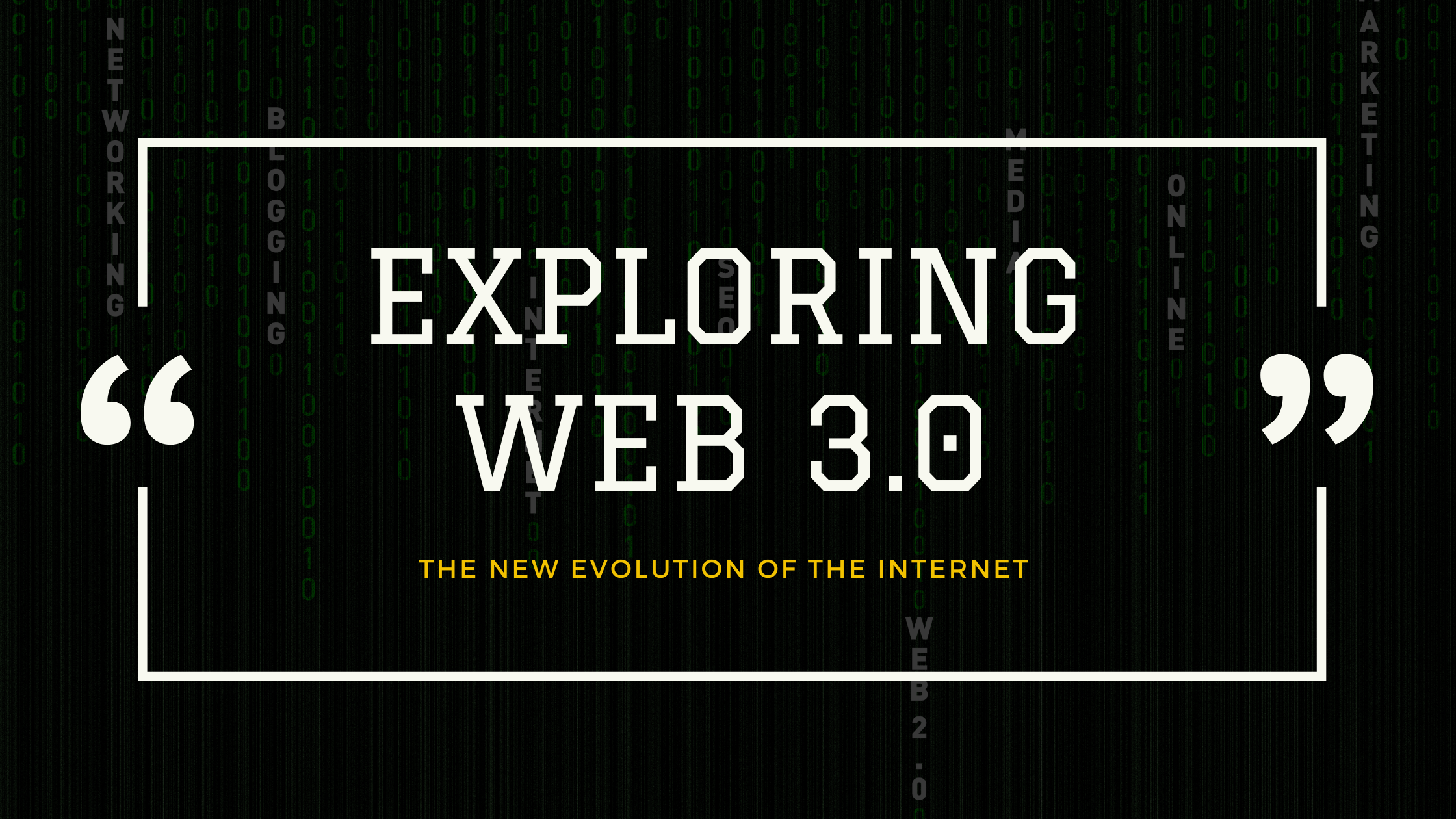.png?width=2240&name=heymate%20blog%20banners%20(4).png)
Have you ever heard of Web 3.0? While almost everyone uses the internet nowadays, scarcely anyone could tell the difference between the different generations of the web.
The central idea of Web 3.0 is that it incorporates the latest element of decentralization, blockchain technologies, and token-based economics to our status quo. Despite criticisms from Tesla CEO Elon Musk arguing that it might merely be a “marketing buzzword”, Twitter co-founder Jack Dorsey actually looks up to it. He argues that Web3 will ultimately end up being owned by venture capitalists.
What is Web 3.0 actually?
Leaving aside these lofty claims, let us look at the basics and discern the differences between different versions of the Webs.
Web 1.0 is usually used to denote the first version of the Web. Originating from the Defense Advanced Research Projects Agency (DARPA), it has later emerged as a publicly accessible webpage. The original webpage was often called “static” as it lacks the interactive feature.
Web 2.0 is used to denote a dynamic version of the internet. In the mid-2000s, users could interact with web pages, communicate with each other, and create content. Apple, Facebook and Youtube were the pioneers that emerged from Web 2.0.
Web 3.0 is still evolving, and it is trending more than ever. It does not have a universally accepted definition. While it is hard to make a consensus on an exemplary definition, one would normally agree that Web 3.0 contains various cutting-edge advancements. Web 3.0 focuses on the technological incorporation of concepts such as decentralization, token-based economies and blockchain. Put differently, Web 3.0 signifies the evolution of web utilization and interaction which includes altering the Web into a database.
One example is that Web 1.0 focuses on information sharing; however, Web 3.0 focuses on the immersion of intelligent web-based functions and apps. Web3 also allows for direct ownership through non-fungible tokens (NFTs).
Decentralization
Decentralization is the notion that ownership is dispersed and disseminated among different users. Instead of having the Internet owned and controlled by centralized entities like Facebook or Google, ownership of the web is decentralized. Rather than consumers accessing the internet through services mediated by traditional oligopoly, the consumers are starting to own and govern sections of the internet.
Other than consumer goods, decentralized finance is a hit too in the financial markets. Decentralized finance or “Defi” was coined in 2018. Rather than relying on the traditional finance sector by the government, the investors themselves are responsible for their assets. It may sound a bit volatile and lack governmental regulation; however, decentralized finance is free from the hands of the regulators. By removing the intermediates, banks or regulators would have no say in the “de-fi”. It would give rise to greater transparency. One also argues it democratizes the financial market, eradicating the involvement of these “Wall Street elites”.
In a nutshell, it is a combination of blockchain technologies to create a financial market that is targeted to bypass banks, brokers, and exchanges.
Blockchain/Token-based economy
Probably you must have heard of Bitcoin. It is the name of the best well-known cryptocurrency, one of which blockchain technology was invented. However, little may you know that Bitcoin belongs to a blockchain. A blockchain is a distributed database or ledger that is shared among the nodes of a computer network. A blockchain is a decentralized, distributed, and public digital ledger and it is independent. The record cannot be altered retroactively without the alteration of all subsequent blocks and the consensus of the network. In simple terms, it is a system of recording information in a way that makes it difficult or impossible to change, hack, or cheat the system.
Apart from Bitcoin, blockchain is being used to process transactions in government. Contrary to public belief, this could be faster than sending money through a bank or other financial institution as the transactions can be verified more quickly and processed outside of normal business hours. Various fintech companies such as Wise or Revolut currently use this kind of technology.
Asset Transfers could also be done by blockchain. It is used to record and transfer ownership virtually. It could either be an intangible asset like NFT or even a real-life asset. Contracts could also be signed via blockchain. These digital contracts are enacted automatically once conditions are met. Blockchain usually gives rise to higher accuracy of transaction and skip the need for intermediaries. In theory, fraudulent transactions could not be attained via a blockchain network.
Non-fungible tokens (NFTs)
If you are a Formula 1 Racing fan, you probably would have realized that some racing drivers had their own NFT for their fans. A non-fungible token (NFT) is a record on a blockchain which is associated with a particular digital or physical asset.
Non-fungible means that one part or quantity may be replaced by another equal part or quantity in paying a debt or settling an account. In other words, “non-fungible” means that it is unique and cannot be replaced with something else. However, fungible means that it is replaceable. Money or Bitcoin are easily replaceable with equal value.
It means that it is useful for verifying intellectual property, authenticating documents and various crypto gaming features.
Advantages of Web 3.0.
Having seen the new Web 3.0 Technologies, applications of Web 3.0 have been becoming an essential part of our life. We can summarize that there are various key Web 3.0 feature
- Decentralised & Permissionless
- Blockchain-based
- Cryptocurrency enabled & trustless
- Autonomous and artificially intelligent applications such as NFT/DeFi
Why is Web 3.0 important?
As is seen above those applications of Web 3.0 have been emerging into our everyday life, one might stop and ponder: Why is Web 3.0 getting popular and important?
A censorship-resistant internet
The opponent of Web 3.0 might immediately argue that the decision by OnlyFans to ban sexually explicit content would be an example that censorship does still exist on Web 3.0. However, Web 3.0 evangelists would argue that was beyond moral turpitude and weak character to condone these contents to be freely flowing on the Internet. With increased data security, scalability, and privacy for users, the influence of large technology companies would wane. A centralised web would enable the regulator to enforce rules and laws. In a decentralized web, content flows freely; thus, this could empower ordinary people by breaking down existing power structures.
However, one would argue that with Web 3.0, information is more connected thanks to semantic metadata. Consequentially, combined with the semantic nature of the Web, this new version of the Web fosters efficient content access and lookup. It could also incentivize data storage and retrieval.
DAOs: Decentralized Autonomous Organization
While this jargon may be difficult to understand, the underlying concept of DAOs is not that difficult to comprehend. In simple words, DAO is an entity structure in which token holders participate in the management and decision-making of an entity. Member within a DAO typically shares a common goal and attempt to act in the best interest of the entity. It can be seen as a democratization of the “bottoms-up management approach”
However, the flip side of being too democratized would be it could render it being inefficient. The time to educate all stakeholders, administer voters, communication and explanation could be both tedious and tiresome. Compared to a meritocratic enterprise, the progress of a DAO’s development could be unduly hampered due to trivial administrative matters. The cost of education and prolonged voting process across different time zone could also render the organization ineffective. Precious time is lost to gathering users due to the decentralized nature; whereas, technological oligopoly could swiftly act upon receiving an expert's advice.
Despite its shortcoming, a DAO raises capital in a way more democratized way. It is just like stocks where a stock raises capital by equity. A DAO raises capital by trading fiat for its native token. The token’s value would be increased when the asset increases in value. The token entails ownership and voting power, and it could be traded to generate income among commoners.
Self-sovereign identity
The concept of self-sovereign identity (SSI) describes an identity management system created to operate independently of third-party. Self-sovereign identity shifts identity and credential management from the client-server model of centralized and federated identity systems, which creates silos, to a peer-to-peer model. In simpler terms, it empowers normal people to control the information provided to websites or applications.
Normally, several large identity providers such as Facebook, Google, and Hotmail contain information associated with one’s identity. SSI, likewise, with other Web 3.0’s applications, gives rise to more freedom and control. Instead of offering personal data to traditional data providers, one could reduce personal data management and have less bureaucracy. SSI can identify an individual through direct, private, peer-to-peer connections secured by public/private key cryptography. With SSI, the power to control personal data dwells with the individual himself. One could authenticate their identity by utilizing the credentials that one wishes to disclose. It reduces the incidence of data piracy. Theoretically, hackers would be unable to hack as each holder generate and control their own decentralised unique identifiers
With higher personal autonomy, also comes with a catch to it. While there are many positive aspects of decentralizing identity providers, there is time and complexity to deciding which platform or method to entrust your data to. Rather than letting companies like Facebook and Google sell your data, there is a greater benefit of autonomy that is a trade-off worth making.
As the Web transforms to a more market-driven format, Web 3.0 will be the marker of this future model of the internet. It would enable new possibilities and opportunities. Time and tide wait for no man. It is a prime time to know more, learn more and perhaps invest in future technologies and applications of Web 3.0.



